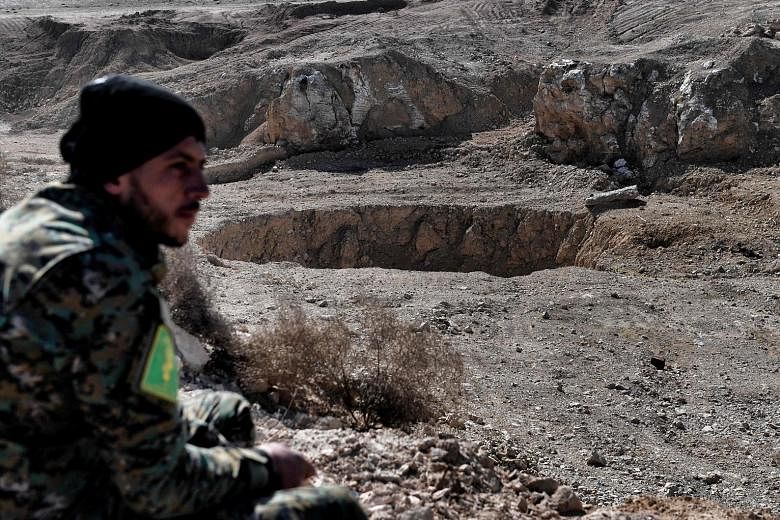ATHBAH (Iraq) • The horror stories about ISIS' mass killings at a cavernous hole in the desert near Mosul became legendary over the years.
Soon after the Islamic State in Iraq and Syria (ISIS) terror group took control of the Iraqi city more than 21/2 years ago, the 30.4m-wide sinkhole, 8km south-west of the airport, became a site for summary executions.
Some victims were made to line up at the edge of the hole and were shot before being kicked inside, while others were tossed in alive, residents said. Sometimes, bodies were just trucked in for dumping.
Residents of Mosul whispered about the deaths at the sinkhole, or "khasfa", as it is called.
But with communication limited and locals too fearful to speak out publicly, it was only after Iraqi forces retook the area last month as they closed in on the city's western side that the scale of the killings at the site began to emerge.
Based on anecdotal evidence, Iraqi officials said thousands could have perished there in recent years.
It may be years more, though, before the mass grave gives up its secrets. No one knows the depth of the hole under the water at the bottom. The militants have filled it and booby-trapped it with explosives, making excavation complex.
Even before ISIS' brutal campaign began, Iraqi authorities were struggling to excavate and identify victims of mass graves dating back to the reign of Saddam Hussein, when as many as a million Iraqis disappeared.
Sectarian war following the 2003 United States-led invasion brought more large-scale bloodletting.
Meanwhile, the authorities are overwhelmed.
Members of Iraq's human rights commission - tasked with mapping ISIS' mass graves - said they could not provide figures on how many have been found so far.
Last year, the Associated Press said it had documented some 72 mass graves from ISIS atrocities in Iraq and Syria, containing as many as 15,000 bodies, with more expected to be unearthed.
Dozens of mass graves around the Iraqi town of Sinjar, which are thought to contain the remains of hundreds of Yazidis killed execution-style by ISIS, have yet to be fully excavated.
Mass graves around the city of Tikrit, containing the remains of an estimated 1,700 soldiers from nearby Camp Speicher, who were massacred by the militants, are still being discovered two years after the area was retaken by security forces.
The khasfa, though, could be the group's biggest mass grave.
"It's swallowed the lives of thousands," said Mr Muthanna Ahmed, who said he worked near the site for five months and witnessed summary executions. "It was terrifying, very deep and dark."
He added that victims' shoes and dried blood lined its rim while some decaying bodies that became caught on the sinkhole's rugged edge were still visible.
A gruesome video posted on YouTube in January 2015 shows a similar scene. The sinkhole was near an ISIS oil refinery, and the militants regularly rounded up workers and Mosul residents who were buying fuel, forcing them to watch the execution-style killings. Victims included former police and army officers, as well as those accused of spying or working with the Iraqi government, witnesses said.
Mr Hussam al-Abar, a provincial council member, said 3,000 to 5,000 corpses might languish in the sinkhole's depths, though he bases that estimate on lists of missing people who, he concedes, could have been killed and buried elsewhere.
"Given the capacity of the central government and local government, I think it's impossible to take out the bodies," he added.
"We'd need international assistance. It would be impossible for Iraqis alone."
Before 2003, the sinkhole was a small tourist attraction drawing travellers from the main Mosul-Baghdad highway about 2km away, Mr al-Abar said. But as violence gripped Iraq in the wake of the invasion, Al-Qaeda began to gain a foothold and the site became a desert grave.
"It was known that whoever wanted to hide a body could drop it into this hole," he noted.
But it was not until after ISIS took control of Mosul in July 2014 that it started being used on an industrial scale.
WASHINGTON POST

